

Training staff on basic vehicle checks is a cornerstone of proactive maintenance. A well-trained staff can significantly reduce downtime and repair costs, while simultaneously bolstering safety protocols. Proper vehicle checks are the first line of defense against costly breakdowns and accidents. This comprehensive guide explores the key elements of training staff on basic vehicle checks for proactive maintenance, providing practical strategies and actionable insights to enhance your organization’s operational efficiency. This article will delve into the importance of this training, define the scope of basic vehicle checks, outline the training process, and ultimately provide recommendations for continued training and implementation. By the end of this article, you will possess the knowledge to design and implement a robust training program.
Understanding the Importance of Proactive Maintenance
Why Basic Vehicle Checks Matter
Proactive maintenance strategies are essential for any organization reliant on vehicles. Regular vehicle checks, performed by well-trained staff, significantly reduce the risk of unexpected breakdowns, which can lead to substantial downtime and repair costs. Beyond the financial implications, proactive maintenance also plays a crucial role in ensuring the safety of personnel and preventing accidents. By addressing potential issues early, organizations can maintain a safe and efficient fleet. Poor maintenance practices are often a factor in accidents, and neglecting routine inspections can lead to severe consequences. Regular checkups are your first line of defense! According to industry reports, organizations that have implemented proactive maintenance programs have seen a 25% reduction in maintenance costs and a 15% reduction in downtime.
Defining Basic Vehicle Checks
Components of a Comprehensive Inspection
Basic vehicle checks encompass a range of inspections that assess the critical systems of a vehicle, including visual inspections, lubrication checks, fluid levels, and other relevant aspects. A thorough inspection should cover critical areas such as tires, brakes, fluids, lights, and overall vehicle condition. A crucial element of this training is establishing a standardized checklist. A checklist will help ensure that no critical area is overlooked. The checklist should be clear, concise, and easy to use. It should also be regularly updated to reflect any changes to vehicle maintenance procedures or new potential issues.
Developing a Training Program
Key Aspects of Effective Staff Training
A well-structured training program is essential for effectively transferring knowledge and skills. This program should comprise both theoretical and practical components. The theoretical aspect should cover the rationale behind vehicle checks and safety procedures, the importance of correct usage of safety equipment, and how to identify potential risks. The practical side should involve hands-on demonstrations and exercises with actual vehicles. This gives staff practical experience in identifying and addressing issues. This provides valuable hands-on practice in recognizing potential problems. Role-playing scenarios to simulate real-world situations can significantly enhance learning.
Implementing the Training Program
Strategies for Successful Rollout
Effective implementation of the training program relies on clear communication, dedicated resources, and ongoing support. Clear communication ensures that all staff understand their roles and responsibilities. Dedicated resources will be required for instructional materials, training facilities, and equipment. Providing continuous support, including regular refresher courses and ongoing feedback, will support the staff to maintain proficiency. Consistent monitoring of staff performance is essential in ensuring the continued quality and effectiveness of this program. Implementing a robust system for monitoring vehicle inspection quality will help identify areas needing improvement and ensure high standards are consistently met.
Related Post : Implementing a Preventative Maintenance Schedule for Your Cars.
Evaluating Training Effectiveness
Measuring the Impact of the Program
Evaluating the effectiveness of the training program is critical to its long-term success. Metrics like the reduction in maintenance costs, improvements in vehicle uptime, and a decrease in accidents can be used to gauge effectiveness. Collecting data on the number of reported issues and resolved issues will provide a strong baseline for evaluating performance and adjusting training if necessary. A system for gathering and analyzing data on performance will provide valuable insights to adjust training programs for maximum effectiveness. By regularly measuring the effectiveness of training, organizations can ensure the training program meets its objectives.
How can I choose the right tools for staff training?
Selecting the appropriate tools for staff training is critical. Consider using a variety of resources, from manuals and videos to hands-on demonstrations and simulated scenarios. Using real-world examples and simulations can enhance learning and engagement. Leveraging technology, such as online platforms and interactive modules, can create a more accessible and engaging learning environment. Also, having clear guidance documents and access to subject matter experts can support staff on their journey of skill acquisition.
What are the key safety considerations during vehicle checks?
Prioritizing safety during vehicle checks is paramount. Ensure staff members are equipped with appropriate safety gear, such as gloves, eye protection, and safety footwear. Stress the importance of recognizing potential hazards and taking necessary precautions to prevent injuries. Clearly outlining safe work practices will mitigate potential hazards and ensure the safety of staff throughout the process.
In conclusion, training staff on basic vehicle checks is crucial for proactive maintenance and minimizing downtime. By establishing clear protocols, providing comprehensive training materials, and regularly conducting practical exercises, organizations can empower their staff to perform these checks effectively. Implementing this training program ensures that vehicles are maintained in optimal condition, leading to enhanced safety, reduced repair costs, and improved operational efficiency. For further assistance or to schedule a tailored training session for your team, contact us today!.